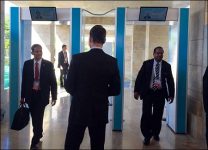
RFID technology provides security for the G20 summit
[ad_1]
In the 2015 G20 Summit held in Turkey, 60,000 politicians, government leaders, and related staff all need to go through UHFRFIDThe system confirms the identity so that there is no need to provide credentials to the security staff. The solution is provided by the Turkish company Litum Technology and DDesign communication system. At the entrance of the conference, 20 RFID reader entrances and handheld readers connected to tablet computers were used.
DDesign provides D-Access software (DAS) to manage the data of each summit participant, including names, photos, countries or organizations, and is responsible for installing this system called Turkey Accreditation. Ali Mahmut, the coordinator of DDesign, said that the system uses DDesign’s server. Participants can register in advance and then receive an appropriately classified badge. Litum selected and provided hardware, including Impinj’s Xportal reader, a badge with the built-in Impinj Monza 4 chip, and a Grok handheld reader that can be inserted into an iPad.

(G20 participants need to walk through the entrance reader, so that the RFID can read the unique ID number in the personal ID card, and then the top LCD screen will display the name and photo of the person.)
A total of 19 heads of state and representatives of the European Union participated in the 10th G20 Summit. The meeting was actually held at the Regnum Carya Hotel Conference Center in Ankara, Turkey. At this meeting, G20 members passed a statement on jointly combating terrorism.
To ensure the safety of the conference, the organizers held a rehearsal one month in advance. Alp ülkü, Litum’s business development manager, said that the Turkish government required Litum and DDesign to jointly develop a solution. The challenge of this system is very unique. Many celebrities participated in this meeting, which also put forward the requirements of not disturbing the entry of these personnel while ensuring safety. Each leader will also bring some consultants, diplomats, etc., these people also need to be efficiently authenticated.

(Security personnel use the ipad inserted into the uGrokit handheld reader to verify the personnel entering the conference center again)
Using this RFID system, the organizer can determine the identity of participants without having to check their credentials or stop them for confirmation.
It took several months for Litum and DDesign to install the xPortal reader. They also worked hard to ensure that the reader could read all the tags worn by the participants.
Every participant (except national leaders) will wear an RFID ID card with their name and photo printed on them. The UHF RFID chip code embedded in the ID card has a unique ID number, which is bound to the person’s name and photo information. DDesign also installed an LCD screen above each entrance to display personnel information.
When each participant walks through the entrance, the reader will read the ID number on the person’s card and display it on the LCD screen. The staff need to visually compare photos and personnel to confirm their identity.

(ID card with built-in Impinj Monza 4 chip)
Security personnel are holding an iPad plugged into the uGrokit handheld reader, so that the person’s photo and name can be read within the reading range. This provides a certain degree of security, and security personnel can use this tool to query information about people close to the head of government.
ülkü said: “Due to the high security needs of top politicians and diplomats, this has become a unique project.” The two companies started designing the reading doors and entrances last summer. He said: “We need to design in a way that is friendly to RF. The project does not allow technical problems.”
After months of testing, DDesign and Litum ensured that the system can provide a 100% read rate.
(Exclusive manuscript of rfid world network, please indicate the source author for reprinting!)
[ad_2]



